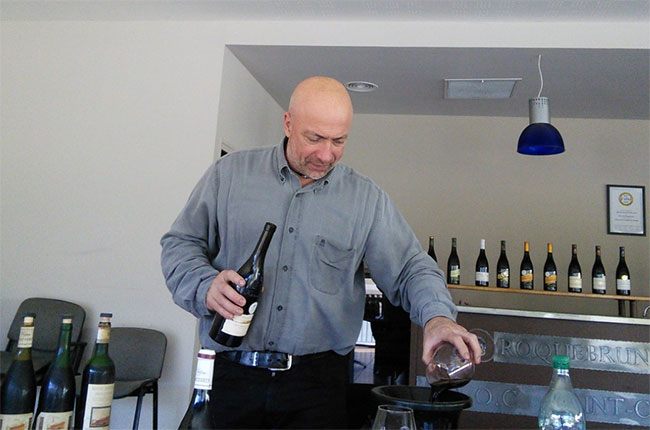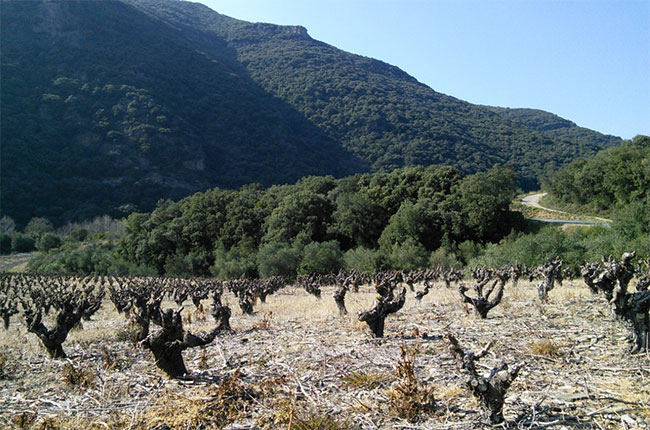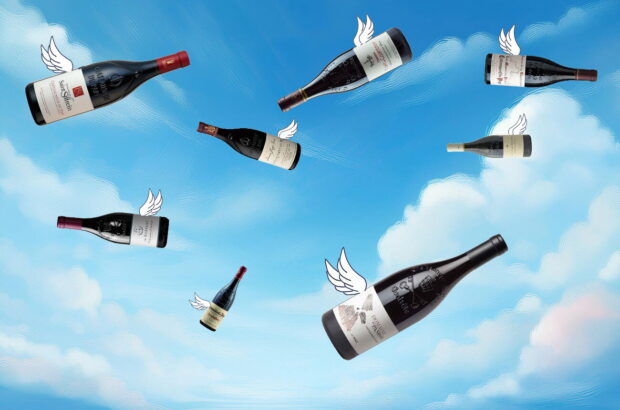Andrew Jefford heads for the remote, schist-soiled Languedoc vineyards of Roquebrun to discover an unusual set of medal-winning wines.
Over the next couple of years, I’ll be intermittently profiling a number of France’s greatest wine co-operatives.
For two reasons: first, because they often offer some of the best value to be had in their appellations: a perennial interest. And second, for their social value: they keep wine-growing alive and viable in vulnerable communities, helping preserve and strengthen France’s extraordinary wine diversity.
When regional success comes, of course, co-operatives sometimes see themselves written out of the story. Will there still be a co-operative in Pauillac (where land changes hands for well over 1.5 million euros per hectare), for example, in 30 years’ time? Many flourishing private domains in well-known regions and appellations owe a debt of thanks their co-operative forebears for sustaining the identity and character of an area through the lean years which preceded success.
In some cases (such as that of Chablis’ La Chablisienne), investment and technical ingenuity can transform a co-operative into a key modern player, and one with untrammeled access to great vineyards. Even in the highest-value land areas, too, co-operatives can play a role – especially when those with tiny landholdings are determined to hang on to them (which is why Champagne still has 136 co-operatives). France’s great co-operatives, in sum, form a little-lauded but vitally important ‘third estate’ in the nation’s wine life.
The co-operative which begins this series, though, hasn’t just kept wine-growing alive in its remote Languedoc hill village, but also provides a fascinating technical study which any student of winemaking would do well to taste and learn from.

The vineyards of Roquebrun. Credit: Andrew Jefford.
When Alain Rogier arrived at the struggling Cave de Roquebrun in St Chinian in 1988, he found its cellar set up for carbonic maceration — then a popular way of softening the asperities of the Carignan which still dominated the vineyards. Rogier could, of course, have modified the installations as Syrah and Grenache arrived – but he was fascinated by the technique and what it could bring to the wines, and over the last 18 years, he has become Southern France’s virtuoso of carbonic maceration. “We’re the biggest producer of carbonically macerated wines in the Languedoc. I’m very happy with that, and very proud of it.”
I first became aware of Roquebrun’s wines during the years when I was chairing the Languedoc-Roussillon panel for the Decanter World Wine Awards. They were regular medal- and trophy-winners: lushly fleshy, exuberant wines which seem to shimmer with beguiling, exotic perfumes. Nor was our competition alone: Rogier was named International Red Winemaker of the Year by the International Wine Challenge last year after Roquebrun won no fewer than two trophies and five gold medals, plus nine silvers and nine bronzes for luck. “One of the sexiest wines EVER,” is how Laithwaite’s buyer Beth Willard feels about the 2011 Fiefs d’Aupenac – at least according to the company’s easily aroused website. “I want to melt into my chair whenever I taste it!” she exclaims. Phew!
The aromatics of schist-grown Syrah fermented by this technique are, it’s true, astonishing. They easily evoke the thyme and privet which grow wild in the garrigue scrubland of the hills, but have a viscerally appealing orange-blossom charm, too, like a night stroll in a Tunisian citrus grove. Nor are these wines unsatisfying on the palate: there is plenty of structure beneath that rich, low-acid flesh, thanks to Rogier’s insistence on what are (for carbonic maceration) unusually long maceration times.

Alain Rogier talks to Andrew Jefford. Credit: Andrew Jefford.
I’ve always wondered how these wines would age, though. “Well,” Rogier assured me when I dropped in to the Roquebrun stand at Vinisud this year. To prove it, he set up two verticals of the Fiefs d’Aupenac and the higher-tier Seigneur d’Aupenac at the winery for me to taste in March (see below). They certainly made the case for ten years’ storage, though taking the wines beyond that is for the brave. If you love the beguiling complexity of their youthful aromas above all, as I do, then the first five years are still the most thrilling.
Roquebrun’s outstanding efforts with carbonic maceration made me wonder why the technique isn’t more widely experimented with elsewhere. While I was taking a few pictures in the lonely, luminous Roquebrun vineyards before driving home, I remembered something Rogier had said which might hint at the answer. Carbonic maceration demands hand-harvesting (see below), and most of the Roquebrun vineyards are so steep that no other picking technique is possible. “The day no one wants to do manual harvesting any more,” he said, “is the day that the AOC of Roquebrun will be uprooted.” The question, as so often, boils down to economics. Those who might be prepared to experiment with carbonic maceration are rarely the same as those who can afford to hand-harvest.
What is carbonic maceration?
Theoretically perfect carbonic maceration would mean that every berry begins to ferment via an intracellular fermentation – inside the unbroken berry, without the agency of yeast, underneath a blanket of CO2. (Hence the need for hand-harvesting: the only way to obtain whole berries on whole bunches.) Once about two degrees of alcohol have been obtained in this way, the berry begins to degrade and release juice, and at that point ambient yeasts join the fermentative process. Fermentation then ‘normalises’ to a greater or lesser extent, depending on the winemaker’s wishes and interventions. (The theoretically perfect ideal is impossible to achieve owing to the effect of gravity in vats, so some yeast-induced fermentation at the bottom of the vat always accompanies the initial intracellular fermentation.)
The intracellular fermentation involves some grape cells respiring anaerobically; as they do this, they produce a different suite of aromatic compounds to those produced in normal fermentation, as well as overseeing a rapid loss in malic acid and rapid gain in glycerol. Perfume and fruit, in other words, are emphasized; tannic structures are softer and rounder; overall acidity is lower and pH higher; and the colour spectrum can be brighter and redder than for conventionally vinified wines.
Carbonic maceration the Roquebrun way
After hand-harvesting (with a big payment differential for quality) at full phenolic maturity, and with sorting to ensure that only “hyper-healthy” fruit is used, the whole bunches are put into separate vats by variety and by vineyard origin. The bunches are covered with CO2 but yeast is also added at this point, to ensure that there are no deviations at the bottom of the vat. Then everything is left alone and untouched – for 25 to 45 days. “Quality is length,” says Rogier.
Even after all of that time, the free-run wine (which is relatively tannic, because of the stems) is only around 25 per cent of the total yield; the other 75% is still in with the bunch-structured marc, and will contain some unfermented sugars. That marc is then pressed (“with carbonic maceration, all of the best quality is the press wine,” says Rogier) – and run into wood to complete its fermentation and undergo malolactic fermentation. These wines are not hurried through the cellar: the 2014 Fiefs d’Aupenac is only being bottled this month, for example. All of this is a nerve-stretching process, with VA, brett, reduction and acetaldehyde a threat. Rogier samples and analyses each vat daily, and will use a little micro-oxygenation if needed; at the first sign of problems, he’ll empty the tank and ferment conventionally. Successful, lengthy carbonic maceration, though, brings soft, ample, plump red wines resonant with those beautifully allusive and engaging aromas.
The ageing challenge
Les Fiefs d’Aupenac, Caves de Roquebrun, St Chinian-Roquebrun 2012
At this stage, this blend of 60 per cent Syrah with 20 per cent each of Grenache and Mourvèdre is moderately scented with meaty, warm, citrussy notes. It’s on the palate that the floral side of its character steps forward and the meatiness retreats a little – tapenade, rose and rosemary are possible allusions you might find. The palate is smooth and ample, soft and supple. 89
Les Fiefs d’Aupenac, Caves de Roquebrun, St Chinian-Roquebrun 2010
Deeply coloured, with the same profile of sweet meatiness, citrus and herbs: the extra two years have smoothed the aromas into one another. Elegant and complete, with slightly fresher, brighter tannins than 2012 and some stony support, though scented fruit still takes the lead here. Holding well. 92
Les Fiefs d’Aupenac, Caves de Roquebrun, St Chinian-Roquebrun 2007
This came from a rainier year and is now at its apogee. Still relatively dark, but the wine smells meaty and mushroomy and mature, while on the palate it’s spicy, rich and full, without any remaining floral or citrus notes. No need to store further. 87
Les Fiefs d’Aupenac, Caves de Roquebrun, St Chinian-Roquebrun 2006
The 2006, 2005 and 2004 were all in very good shape, though after that it was only the aromatically complex 1998, the still-structured 1994 and the soft but very graceful 1992 which were still holding their own. The 2006 no longer shimmered with citrus and thyme; instead chocolate, earthy and tobacco dominated the allusions. On the palate, this is a graceful and complete wine with the merest veil of tannin; all of its complexity lies in its aromatic resonance. 91
Seigneur d’Aupenac
Seigneur d’Aupenac, Caves de Roquebrun, St Chinian-Roquebrun 2011
The blend for this cuvée (first made in 2001) is based on 70 per cent Syrah with Grenache and Mourvèdre. The 2011 has outstanding aromas just now. That distinctive Roquebrun perfume of orange blossom, lily and jasmine plus lavish red and black fruit beneath is here, in energetic form: truly seductive Languedoc Syrah with the aromatic volume lifted by carbonic maceration. The palate, too, billows with all of that floral profusion, and there’s a little fresher redcurrant in with all the richer black fruits. 91
Seigneur d’Aupenac, Caves de Roquebrun, St Chinian-Roquebrun 2009
This warm year has produced a rich, sweet, almost portly Seigneur with fewer floral notes than normal, but plenty of architecture nonetheless: ample stone and liquorice notes in the sweet blackcurrant and blackberry fruits. The soft texture is perhaps the chief legacy of carbonic maceration here. 90
Seigneurs d’Aupenac, Caves de Roquebrun, St Chinian-Roquebrun 2006
The outstanding 2006 is in great shape just now, though once again it is hard to see floral or wild-herb perfumes any more after ten years in the cellar; the scent reminded me of Dundee fruit cake. It’s generous, lush and utterly giving on the palate, packed with soft, choice morsels of fruit: dense without toughness; balanced despite the low acidity. 92
Les Seigneurs d’Aupenac, Caves de Roquebrun, St Chinian-Roquebrun 2002
The 2002 was a fully mature wine, but still delicious to drink: dried herb and tobacco scents, with graceful and fine-grained but still voluptuous flavours built on a core of now-truffley plum-prune fruit. 91
And to finish …
Baron d’Aupenac, Caves de Roquebrun, St Chinian-Roquebrun 2008
Roquebrun’s top wine (almost pure Syrah) is called Baron d’Aupenac and it, too, is made by carbonic maceration. The 2008 at present has dark, rooty, warm and comforting aromas and a truly splendid palate, packed with enveloping wealth and density, yet devoid of any toughness. It’s on the palate rather than in the aromas, in fact, that you find the distinctive plant and herb fragrances (no more flowers), now modulating towards a spicier, earthier maturity. 93
More Andrew Jefford columns:

Jefford on Monday: The yachtsman’s white
Will Vermentino ever be considered a world great?

Jefford on Monday: Dr Mistral

Jefford on Monday: Sardinia’s Secrets
Andrew Jefford visits Italy’s ‘other’ wine island...

Jefford on Monday: Hitting first
Andrew Jefford looks at two recent political controversies for French wine, and considers their impact...







